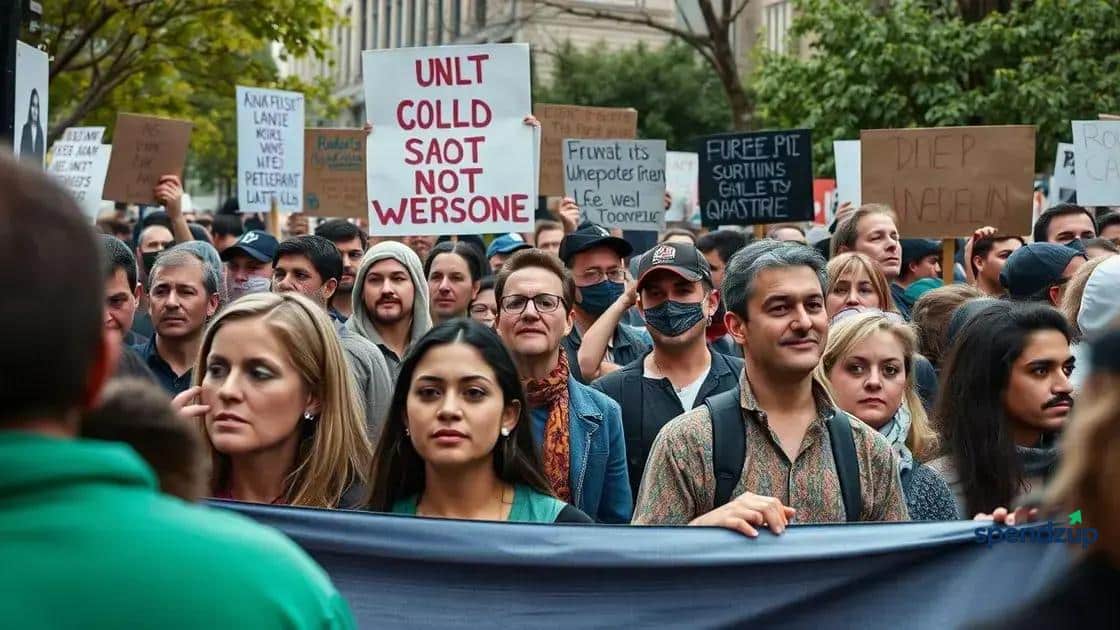Hands Off protests: Exploring public sentiment and engagement

The Hands Off movement focuses on social justice and police reform, leveraging social media for organization and awareness while engaging communities to drive change effectively.
Hands Off protests are gaining momentum as citizens unite to express their frustrations and demands for change. What drives this movement?
Let’s dive into the heart of these demonstrations and explore their significance.
The origins of Hands Off protests
Understanding the origins of Hands Off protests requires delving into the history and context that led to this powerful movement. These protests began as a grassroots response to specific societal issues that people felt strongly about. As communities united, the protests grew in size and intensity, reflecting a rising frustration with systemic problems.
Key Historical Events
Several pivotal events have shaped the desire for activism. These include:
- Increased awareness of social injustices
- High-profile incidents sparking public outrage
- Community leaders advocating for change
- The role of the internet in mobilizing supporters
Many individuals found their voices during these moments, leading to a wave of activism. The connection among protesters was fueled by shared values and a desire to effect change. As more people joined, the Hands Off protests gained visibility and momentum.
Community Engagement
Moreover, the formation of local groups has been essential. These groups often focus on specific issues that resonate with their communities. They organize events, hold meetings, and facilitate discussions to educate the public. This grassroots effort is crucial as it fosters a sense of belonging and empowerment among participants.
Ultimately, the Hands Off protests reflect a collective voice against oppression. This movement serves not just as a reaction to events but also as a call for proactive change. Through unity, determination, and awareness, participants aim to reshape their communities.
Key issues driving the movement

Many key issues driving the movement behind the Hands Off protests stem from deep-seated societal problems. These concerns resonate with a broad audience, motivating people to take action. Understanding these issues is crucial for recognizing the importance of the protests.
Social Justice
One of the primary issues is the fight for social justice. Many communities feel marginalized and underrepresented. They demand equal treatment and opportunities, highlighting the need for changes in policies that govern their lives.
- Racial equality and anti-discrimination
- Economic disparities impacting marginalized communities
- Access to education and healthcare
- Environmental justice concerns affecting vulnerable populations
These topics fuel discussions and encourage collaboration among activists. As the movement grows, participants place a significant emphasis on social justice, breaking down barriers in their communities.
Police Reform
Another vital issue is police reform. Many protests have been sparked by incidents involving law enforcement, leading to demands for changes in policing practices. Citizens are increasingly aware of the need for accountability and transparency.
People are advocating for:
- Better training for police officers
- Use of body cameras
- Community policing initiatives
- Increased oversight of law enforcement agencies
These calls for reform reflect a desire for a safer and more just society. Activists believe that significant changes in law enforcement practices can lead to better community relations.
As the Hands Off protests highlight these issues, they also serve as a rallying point for those who want change. By addressing these key issues, participants focus on building a stronger, more equitable future for all.
How Hands Off protests are organized
Understanding how Hands Off protests are organized reveals the underlying structure that fuels their effectiveness. Organizers play a critical role in mobilizing people and creating a focused agenda. They work tirelessly to coordinate events, communicate with the public, and ensure that voices are heard.
Grassroots Mobilization
At the heart of these protests lies grassroots mobilization. This approach connects local communities and encourages active participation. Organizers often utilize social media to spread the word quickly and effectively, reaching a large audience in a short amount of time.
- Utilization of platforms like Facebook, Twitter, and Instagram
- Creation of event pages to inform and engage participants
- Encouraging supporters to share details with their networks
- Using hashtags to increase visibility
This grassroots approach ensures that the movement remains community-driven, empowering individuals to take part in something larger than themselves.
Strategies for Effective Protests
Organizers often develop specific strategies to enhance the impact of the protests. These may include planning peaceful marches, sit-ins, or rallies to draw attention to their causes. A well-structured protest can attract media coverage, further amplifying the message.
Key strategies may involve:
- Identifying high-traffic locations for maximum visibility
- Coordinating with local law enforcement for safety
- Providing training for participants on how to engage peacefully
- Creating clear messaging that outlines the goals of the protest
Through strategic planning, the Hands Off protests can focus on significant issues while maintaining a united front. This organization fosters a sense of community among participants, creating a space for individuals to come together and advocate for change.
The impact of social media on protest effectiveness

The impact of social media on protest effectiveness is significant and multi-faceted. This platform allows for rapid communication and mobilization, enabling activists to reach a larger audience than ever before. As protests gain momentum, social media plays a crucial role in shaping public perception and engagement.
Real-Time Communication
With social media, organizers can share updates instantly. This capability is vital during protests, where conditions can change quickly. By using platforms like Twitter and Instagram, participants can stay informed about meeting points, schedules, and any alterations in plans.
- Live streaming of events to inform a broader audience
- Creating event pages to gather participants
- Sharing images and videos to showcase protest activities
- Using polls and questions to engage the community
This real-time aspect enhances responsiveness and fosters a sense of urgency which helps to mobilize supporters effectively.
Raising Awareness
Social media also helps raise awareness about the issues being protested. Hashtags like #HandsOff can unify messages and create trends. When topics trend, they attract media attention, which amplifies the cause.
Besides trending topics, compelling visuals shared on social media can evoke strong emotions. Many individuals share their stories and experiences, which humanizes the issues at stake. This personal touch can resonate deeply with others, encouraging participation and support.
Furthermore, educational campaigns launched through social media can provide essential information on social justice issues, ensuring that participants are well-informed. By empowering individuals with knowledge, social media helps cultivate a larger base of informed protestors.
As a result, the impact of social media on protest effectiveness is profound. It transforms how protests are organized and executed, fostering engagement that reaches beyond physical gatherings.
Future of the Hands Off movement
The future of the Hands Off movement looks promising, as the commitment to social change continues to grow among communities. With each protest, more individuals are inspired to join the cause, spreading awareness and creating a larger network of support. The movement’s adaptability plays a key role in its evolution as it responds to emerging issues.
Ongoing Engagement
For the Hands Off movement to thrive, ongoing community engagement is essential. This means maintaining conversations around important social issues and involving a diverse group of voices. Strengthening these connections helps ensure that the movement remains relevant and impactful.
- Regular meetings and workshops for education
- Involvement of youth voices to bring fresh perspectives
- Collaboration with local organizations and allies
- Utilization of various platforms for discussion, both online and offline
These efforts aim to keep the momentum alive, making it easy for people to stay informed and involved in significant social issues.
Adapting Strategies
As society changes, so too must the strategies employed by the Hands Off movement. Adapting to the times ensures that protests and campaigns are effective. Embracing technology can enhance outreach and organize protests more efficiently.
Some adaptive strategies include:
- Leveraging social media for broader reach
- Incorporating digital tools for organizing events
- Encouraging grassroots involvement through localized groups
- Emphasizing intersectional approaches to include various social issues
This flexibility can attract new participants who see the movement as relevant to their experiences and concerns.
Looking ahead, the Hands Off movement has the potential to impact future generations profoundly. By prioritizing education, engagement, and effective strategies, this movement can evolve and continue to address pressing social issues.
In summary, the Hands Off movement continues to grow and evolve
This movement has shown us the power of community and the importance of raising our voices for change. By addressing key issues such as social justice and police reform, participants work together to create a more equitable future.
Social media plays a vital role in organizing protests and spreading awareness, allowing for real-time communication and engagement. As the movement adapts to new challenges and embraces technology, it remains relevant to the needs of its community.
With ongoing commitment, education, and collaboration, the Hands Off movement will undoubtedly pave the way for future generations to advocate for their rights and strengthen their communities. It is essential for every individual to participate, ensuring that everyone’s voice contributes to the ongoing quest for justice and equality.
FAQ – Frequently Asked Questions about the Hands Off Movement
What are the main goals of the Hands Off movement?
The main goals include promoting social justice, advocating for police reform, and raising awareness about systemic issues affecting communities.
How does social media influence the Hands Off protests?
Social media helps in organizing events, sharing updates in real-time, and raising awareness, significantly increasing participation and impact.
What strategies do organizers use to keep the movement effective?
Organizers focus on grassroots mobilization, ongoing community engagement, and adapting strategies to meet emerging challenges and opportunities.
How can individuals support the Hands Off movement?
Individuals can support by participating in protests, sharing information on social media, volunteering with local organizations, and educating themselves and others about the issues.





